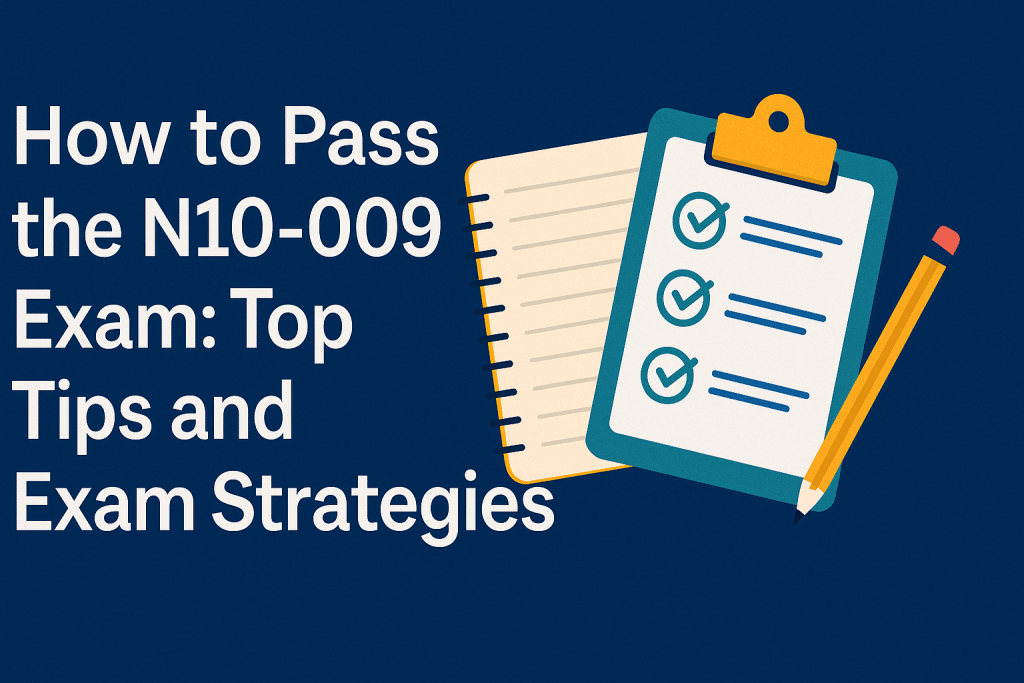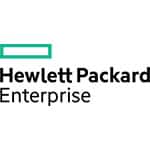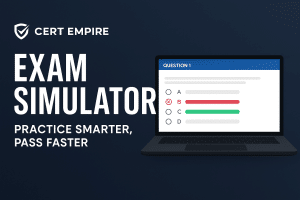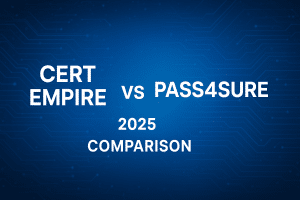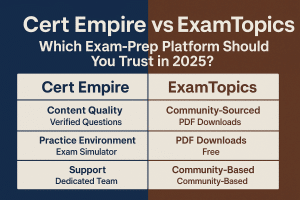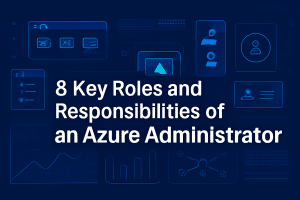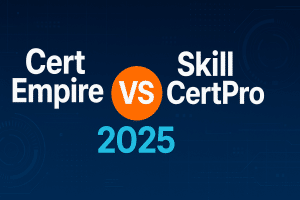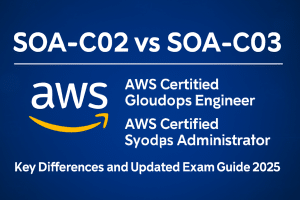Are you planning to take the CompTIA Network+ N10-009 exam? Great choice! This certification is a solid stepping stone if you’re looking to build a career in networking, whether as a network technician, IT support specialist, or even a systems administrator. But let’s be real, many people worry about passing the certification exams because they don’t have a clue about N10-009 exam preparation and technical skills.
Is it tough? Yes, but not impossible. With the right study plan and smart exam strategies, you can pass the N10-009 on your first attempt. The trick is knowing what to study, how to study, and how to prepare effectively tackle the exam questions effectively.
| Aspect | Details |
|---|---|
| Exam Code | N10-009 |
| Focus Areas | Networking fundamentals, Network security, Cloud computing, Automation, Troubleshooting |
| Key Skills Gained | Troubleshooting, Configuring networks, Cloud & virtual networks, Network security |
| Exam Format | 90 questions (Multiple-Choice & Performance-Based) |
| Duration | 90 minutes |
| Passing Score | 720 out of 900 |
| Cost | $369 (exam fee) |
| Recommended Experience | At least 9 months of networking experience |
| Study Time | 2-3 months (for beginners), 4-6 weeks (with IT experience) |
| Exam Domains | 1. Networking Fundamentals (25-30%) 2. Network Security (20-25%) 3. Cloud & Virtualization (15-20%) 4. Network Performance & Troubleshooting (20-25%) 5. Automation & Emerging Technologies (10-15%) |
| Common Mistakes | Relying on only one study method, Ignoring performance-based questions, Lack of hands-on experience |
| Pass Rate | Estimated 70-80% pass rate |
| Best Study Resources | Study guides, practice exams, online courses, hands-on labs (Packet Tracer, GNS3) |
| Post-Certification Career Paths | Network Administrator, Network Engineer, IT Support Specialist |
What’s Inside the N10-009 Exam Domains?
The N10-009 exam is a valuable credential and it isn’t just about memorizing a bunch of networking terms and hoping for the best. CompTIA wants to see if you actually understand how networks function, how to troubleshoot issues, and how to apply security measures. So, they test you on real-world computer networking concepts, not just definitions.
Here’s a breakdown of the main topics you will face:
✔ Networking Fundamentals – The basics. IP addressing, protocols, OSI vs. TCP/IP models, subnetting technologies, and the core components of a network devices (switches, routers, firewalls, etc.).
✔ Network Implementations – This is about setting up and configuring wired and wireless networks, VLANs, VPNs, and cloud-based networking infrastructure.
✔ Network Operations – Monitoring, managing, and optimizing networks and data,, plus handling performance issues. This part often trips up people who haven’t had hands-on experience.
✔ Network Security – Cybersecurity is big. Expect questions on firewalls, access control network monitoring, authentication, encryption, and risk management. CompTIA loves testing this.
✔ Troubleshooting – Real-world problems. You get given a scenario, and you need to figure out what’s wrong. Could be a slow network, DNS issues, misconfigured settings, or connectivity failures.
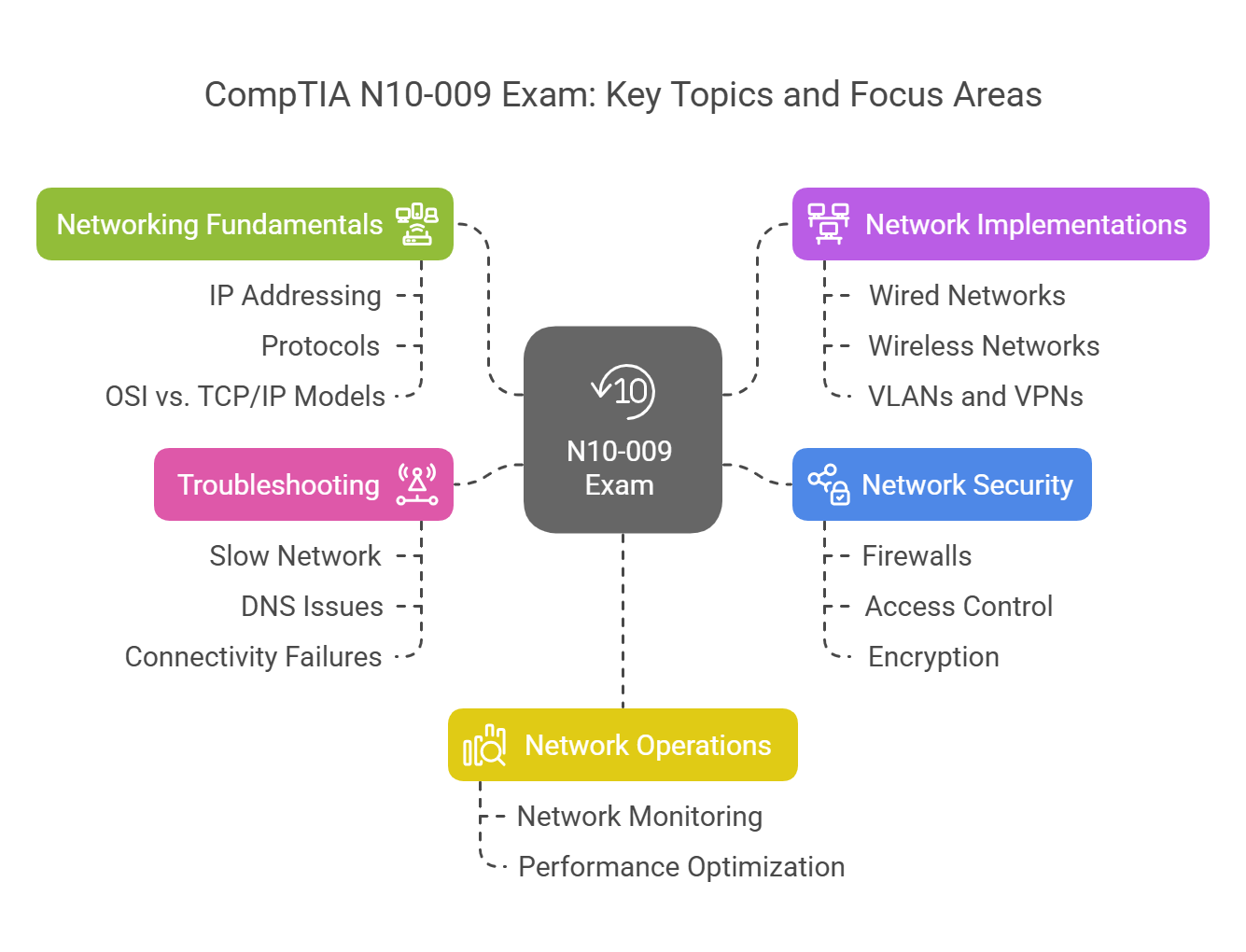
Want a deeper dive into how the N10-009 exam has evolved in 2025 and what new topics have been added? Check out the full guide on the N10-009 certification for a complete breakdown of domains and trends.
How the Exam is Structured (And Why It Matters)
Before you start studying, you gotta know how the test is set up. CompTIA doesn’t make this a straightforward multiple-choice exam. They mix things up to see how well you can think under pressure.
- Total Questions: Up to 90
- Time Limit: 90 minutes (no extra time for thinking too long)
- Question Types: Multiple-choice, drag-and-drop, and PBQs (performance-based questions)
- Passing Score: 720 out of 900
The trick here? Time management is everything. If you get stuck on a PBQ early on, you might lose too much time. Always skip the harder questions and come back to them later if needed.
Performance-Based Questions (PBQs) – Are They Really That Hard?
Short answer: Yes, if it career you’re unprepared.
Long answer: These aren’t your usual “choose the best answer” type of questions. Instead, you’re dropped into a virtual environment where you have to complete real networking tasks. You might have to:
- Set up VLANs on a switch
- Fix an IP addressing issue
- Configure a firewall to block certain traffic
- Troubleshoot a non-working network connection
The biggest mistake people make? Panicking. These questions like software defined networking look intimidating, but CompTIA only tests what’s covered in the exam objectives. If you’ve practiced setting up networks or troubleshooting issues in a lab environment, you’ll be fine.
Scoring – How is Your Performance Evaluated?
The CompTIA scoring system is a little weird. You don’t just get points for answering questions correctly, some questions carry more weight than others.
- Not all questions are worth the same – Some count for more, some might even be beta questions (which don’t affect your score at all).
- Partial credit exists – If a PBQ has multiple steps and you get most of them right, you might still get some points instead of losing everything.
- Passing score is 720 out of 900 – That means you don’t need to aim for perfection, just be solid across all topics.
The trick is to focus on the high-value questions first; PBQs and troubleshooting ones, and not waste time on questions that you already know or are too difficult to solve quickly.
Best Study Materials for N10-009 Exam Prep (Cut Through the Noise)
Finding the right study materials for CompTIA Network+ (N10-009) can feel like being lost in a maze. There’s a flood of books, video courses, practice tests, and hands-on labs, each claiming to be the best. The problem? Not all resources are created equal. Some are straight-up boring, others are outdated, and a few are just plain useless.
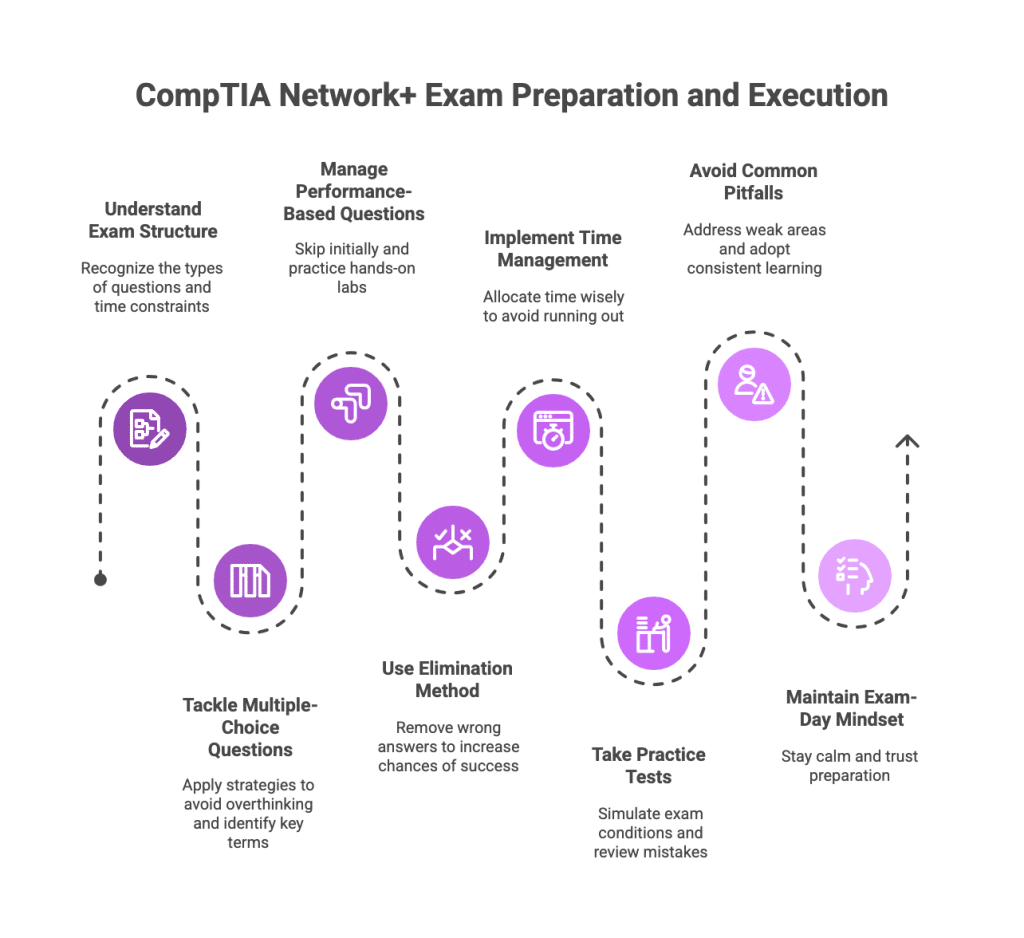
So, let’s cut through the noise and break down what actually works.
Official vs. Third-Party Study Guides – Which One Should You Trust?
CompTIA itself puts out official study materials for the exam. While they’re accurate and cover everything in the syllabus, they aren’t always the best for real learning. Why? They tend to be dry, overly detailed, and sometimes hard to digest.
Here’s the breakdown of what’s worth your time:
✔ CompTIA Official Network+ Study Guide (N10-009) – If you want everything straight from the source, this is it. Covers every exam topic in detail, but the wording can be a bit stiff. Works great as a reference book.
✔ CompTIA CertMaster Learn + Labs – This is CompTIA’s official e-learning platform. Comes with lessons, practice questions, and virtual labs. Expensive but good for interactive learners.
✔ Third-Party Books (Better for Beginners) – These are usually easier to understand than CompTIA’s official book. Some of the best:
- Mike Meyers’ CompTIA Network+ Guide to Managing & Troubleshooting Networks – More engaging, breaks things down clearly.
- Todd Lammle’s Network+ Study Guide – Covers theory + hands-on labs, making it useful for practical learners.
Verdict? If you’re already somewhat familiar with networking, the official guide is fine. But if you need an easier way to do it industry digest the content, go for Mike Meyers or Todd Lammle.
Are CompTIA’s Online Training and Virtual Labs Worth It?
If you’ve seen CompTIA’s CertMaster Labs and e-learning courses, you might be wondering if they’re worth the money. Short answer? It depends.
🔹 CertMaster Learn + Labs – Good if you need a structured course with hands-on simulations. Expensive, but works well if you’re self-studying and don’t have access to real networking equipment.
🔹 CompTIA CertMaster Practice – A question bank for testing your knowledge. Not bad, but there are cheaper alternatives.
Who should get it? If you struggle with hands-on networking experience, CertMaster Labs can help. But if you’re already comfortable with configuring networks, you can skip it.
Mastering the Art of Study Planning: What Works & What Doesn’t?
Studying for CompTIA Network+ (N10-009) is not just about grinding through books and watching training videos alone. If you don’t have a plan, you’ll either burn out or forget most of what you learned before the exam. A structured study schedule is the difference between confidently passing on the first try and retaking the exam because you crammed last minute.
The key is studying smarter, not harder. You don’t need to spend 8 hours a day buried in notes. Instead, you need a plan that covers everything in a logical order, reinforces concepts without overwhelming you, and balances theory with hands-on practice.
Why a Structured Study Schedule is Non-Negotiable
Most people fail not because the exam is too hard, but because they study the wrong way.
- Studying randomly – One day you’re learning subnetting, the next you’re watching a video on wireless security. No structure = No retention.
- Cramming last minute – Memorizing a bunch of facts the night before the exam won’t help when you get a troubleshooting scenario or a PBQ.
- Skipping hands-on practice – Reading about configuring routers is not the same as doing it in a lab. You’ll freeze up on PBQs if you don’t practice.
- Structured study keeps you focused – You learn one thing at a time, build on previous knowledge, and don’t feel lost.
- Spacing out your study sessions helps retention – If you review concepts regularly, you’ll remember them without struggling.
- A mix of theory and labs makes everything click – When you understand how things work, exam questions feel easy.
The Best Way to Mix Theory & Hands-On Practice
The golden rule of studying for Network+ is don’t just read. DO.
- Watch a video, then immediately test yourself – If you watch a subnetting tutorial, solve 5 subnetting questions right after.
- Use labs to reinforce knowledge – Read about VLANs? Open Packet Tracer and create VLANs yourself.
- Take quizzes before moving to a new topic – If you can’t answer basic questions on a topic, you’re not ready to move forward.
- Do hands-on labs at least 3x a week – Even 30 minutes of practice makes a huge difference.
- Use practice exams as study tools, not just a final test – Every mistake is a chance to reinforce weak areas.
How to Tackle CompTIA Network+ Exam Questions Like a Pro
Studying is one thing, but how you handle the actual exam matters just as much. Many test-takers struggle not because they don’t know the content, but because they make mistakes in how they answer questions. Whether it’s overthinking multiple-choice questions, panicking over PBQs, or mismanaging time, small errors can cost you your passing score.
Here’s how to approach every question strategically so you can walk into the exam with confidence.
Multiple-Choice Questions: Why Overthinking Can Cost You Marks
Most of the N10-009 exam consists of multiple-choice questions (MCQs), but that doesn’t mean they’re all easy. CompTIA loves to add extra details, distractors, and similar-sounding terms to confuse you.
- Stick to what you KNOW – If a question is straightforward, don’t second-guess yourself. Many candidates change a correct answer to a wrong one by overthinking.
- Look for key terms – Words like “always,” “never,” “most likely,” or “best option” change the meaning of the question.
- Watch out for distractors – Some answer choices sound right but don’t fully match the question.
- If unsure, go with the most general answer – If two answers seem correct, pick the one that applies in the broadest context.
Performance-Based Questions (PBQs): Smart Approaches to Solving Them Efficiently
PBQs (Performance-Based Questions) are where many candidates lose points and time. These require you to set up a network, troubleshoot an issue, or configure a firewall in a simulated environment.
- Skip PBQs first, come back later – They take more time than multiple-choice questions, so don’t waste precious minutes at the beginning.
- Practice hands-on labs before the exam – If you’ve set up VLANs, subnetted networks, and worked with command-line tools, PBQs won’t feel as intimidating.
- Read the instructions carefully – PBQs sometimes include hints in the wording that tell you exactly what to do.
- Don’t panic if something looks unfamiliar – Use logical troubleshooting and focus on basic networking principles.
The Elimination Method – How to Handle Tricky Questions When Unsure
Even if you’ve prepared well, you WILL get some questions that stump you. Instead of guessing randomly, use elimination to increase your chances of picking the right answer.
- Remove obvious wrong answers – CompTIA often includes one or two choices that are completely wrong. Cross them out mentally.
- Compare similar-sounding options – If two answers seem almost the same, one of them is probably a distractor.
- Go back to networking fundamentals – If stuck, ask yourself: What makes the most sense in a real-world network?
- Use educated guessing wisely – If you’re completely lost, pick the answer that follows best practices (e.g., security-first approach).
For a complete overview of all domains, objectives, and the latest exam updates, explore the full N10-009 CompTIA Network Certification Guide 2025.
Time Management Strategies: How to Avoid Running Out of Time in the Exam
90 minutes for 90 questions sounds like plenty of time, until you realize PBQs take longer than standard multiple-choice ones. Many candidates fail simply because they don’t pace themselves properly.
Don’t spend more than 60-90 seconds per question – If you don’t know the answer, mark it for review and move on.
Skip PBQs at first – These can take 5-7 minutes each. Answer multiple-choice questions first, then use remaining time for PBQs.
Use the last 10-15 minutes to review flagged questions – If you marked a question earlier, go back with fresh eyes.
Practice Tests: Your Secret Weapon for N10-009 Success
Studying is important, but practice exams are where you build real confidence.
How Many Practice Exams Should You Take Before the Real Test?
At least 3-5 full-length exams – Take timed tests to simulate real exam pressure.
Don’t stop at just answering questions – Review every mistake and understand why you got it wrong.
What Makes a Good Practice Test vs. a Misleading One?
Good tests mirror the real exam format, difficulty level, and question types. You can get help from the N10-009 exam dumps by Cert Empire, and if you want to test yourself right away, start with a free network+ practice question to experience the exam style firsthand.
Bad tests include outdated questions or overly simplified answers that don’t reflect actual CompTIA standards.
The Science of Reviewing Mistakes – Why Analyzing Wrong Answers is More Important than Getting Them Right
Every wrong answer exposes a knowledge gap – If you don’t understand why you got something wrong, you’ll repeat the mistake.
Track your weak areas – If you keep missing subnetting questions, spend extra time mastering it.
Practice the reasoning, not just the answer – CompTIA rewords questions, so memorizing won’t help, understanding will.
Common Pitfalls That Lead to Failure (And How to Avoid Them)
Subnetting & CIDR Notation – Many candidates skip subnetting practice, thinking it won’t be tested much. Big mistake.
Command-Line Tools – Know commands like ping, tracert, netstat, nslookup, and ipconfig.
Wireless Security Standards – CompTIA loves asking about WPA3, encryption methods, and authentication protocols.
Cramming vs. Consistent Learning – Which is More Effective?
- Cramming overloads your brain – You might remember facts short-term, but you’ll struggle with PBQs and applied questions.
- Spacing out study sessions improves retention – Studying a little each day over 6-8 weeks is far better than an all-nighter.
Why Some Candidates Fail Despite Studying Hard (And What to Do Differently)
- They study randomly with no structure – If you don’t follow a study plan, you’ll waste time on unimportant details.
- They memorize instead of understanding – This works for definitions, but not for real-world scenarios.
- They neglect hands-on practice – PBQs expose those who only read books but never configured a network.
The Importance of Test-Taking Mindset and Exam-Day Confidence
- A calm mindset = better recall – Anxiety can make you forget answers you actually know.
- Trust your preparation – If you’ve done full-length practice tests, you’re ready.
Exam Day Tips: Stay Focused and Nail It
What to Bring (and NOT Bring) to the Testing Center
Bring: Two forms of ID, Pearson VUE login details, water bottle, and a sweater (testing rooms can be cold).
Don’t bring: Notes, electronics, or bulky items, you will have to store everything in a locker.
How to Stay Calm Under Pressure and Avoid Last-Minute Panic
- Arrive early – Rushing makes you nervous. Get there at least 30 minutes before your slot.
- Take deep breaths – If your mind blanks, close your eyes for five seconds, then refocus.
Time Breakdown: How to Pace Yourself Through 90 Minutes of Intense Testing
- First 10 minutes: Quick scan, answer easy MCQs.
- Next 40 minutes: Handle harder MCQs.
- Final 40 minutes: PBQs and reviewing flagged questions.
Post-Exam Expectations: What Happens If You Pass (or Fail)?
- If you pass: Your certification is valid for 3 years.
- If you fail: Review weak areas, retake in 14 days.
Master these strategies, and you’ll walk out of the N10-009 exam with a passing score.
FAQs (People Also Ask Section)
- How long does it take to prepare for the N10-009 exam?
Most candidates need about 6-8 weeks, depending on their prior knowledge and study pace. - What is the hardest part of the N10-009 exam?
Performance-based questions (PBQs) are often the most challenging since they require practical problem-solving rather than memorization. - Can I pass the N10-009 exam without networking experience?
Yes, but hands-on labs and real-world practice are highly recommended for better understanding. - Are Cert Mage dumps reliable for N10-009 exam prep?
Cert Mage dumps can be a valuable resource for practice, but they should be used alongside official study materials for the best results. - Is the N10-009 certification worth it in 2025?
Absolutely! It remains a key certification for entry-level network professionals and is recognized worldwide.
Last Updated on by Team CE

